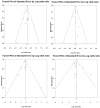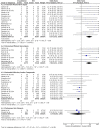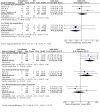Cryoballoon versus Radiofrequency Ablation for Atrial Fibrillation: A Meta-analysis of 16 Clinical Trials
- PMID: 28496925
- PMCID: PMC5368545
- DOI: 10.4022/jafib.1429
Cryoballoon versus Radiofrequency Ablation for Atrial Fibrillation: A Meta-analysis of 16 Clinical Trials
Abstract
Introduction: We aimed to study the procedural characteristics, efficacy and safety of cryoballoon ablation (CBA) versus radiofrequency ablation (RFA) for catheter ablation of paroxysmal atrial fibrillation (AF). Methods: A systematic literature search was performed using PubMed, EMBASE, Web of Science, and Cochrane Central Register of Controlled Trials to clinical trials comparing CBA and RFA for AF. Outcomes were evaluated for efficacy, procedure characteristics and safety. For each study, odd ratio (OR) and 95% confidence intervals (CIs) were calculated for endpoints for both approaches. Results: We analyzed a total of 9,957 participants (3,369 in the CBA and 6,588 in RFA group) enrolled in 16 clinical trials. No significant difference was observed between CBA and RFA with regards to freedom from atrial arrhythmia at 12-months, recurrent atrial arrhythmias or repeat catheter ablation. CBA group had a significantly higher transient phrenic nerve injury (OR 14.19, 95% CI: 6.92-29.10; p<0.001) and persistent phrenic nerve injury (OR 4.62, 95% CI: 1.97-10.81; p<0.001); and a significantly lower pericardial effusion/cardiac tamponade (OR 0.43, 95% CI: 0.26-0.72; p=0.001), and groin site complications (OR 0.60, 95% CI: 0.38-0.93; p=0.02). No significant difference was observed in overall complications, stroke/thromboembolic events, major bleeding, and minor bleeding. Conclusion: CBA was non-inferior to RFA for catheter ablation of paroxysmal AF. RF ablation was associated with a higher groin complications and pericardial effusion/cardiac tamponade, whereas CBA was associated with higher rates of transient and persistent phrenic nerve injury.
Keywords: Atrial Fibrillation; Catheter Ablation; Cryoballoon; Radiofrequency.
Figures













Similar articles
-
A systematic review and meta-analysis comparing second-generation cryoballoon and contact force radiofrequency ablation for initial ablation of paroxysmal and persistent atrial fibrillation.J Cardiovasc Electrophysiol. 2020 Oct;31(10):2559-2571. doi: 10.1111/jce.14676. Epub 2020 Jul 23. J Cardiovasc Electrophysiol. 2020. PMID: 32671920
-
Efficacy and Safety of Cryoballoon Versus Radiofrequency Ablation for Persistent Atrial Fibrillation: A Meta-Analysis of Randomized Controlled Trials.Cardiol Rev. 2025 May 22. doi: 10.1097/CRD.0000000000000947. Online ahead of print. Cardiol Rev. 2025. PMID: 40401921
-
Cryoballoon versus radiofrequency ablation for persistent atrial fibrillation: a systematic review and meta‑analysis.Kardiol Pol. 2020 Jan 24;78(1):20-29. doi: 10.33963/KP.15048. Epub 2019 Nov 5. Kardiol Pol. 2020. PMID: 31688837
-
Outcomes of cryoballoon or radiofrequency ablation in symptomatic paroxysmal or persistent atrial fibrillation.Europace. 2019 Sep 1;21(9):1313-1324. doi: 10.1093/europace/euz155. Europace. 2019. PMID: 31199860 Free PMC article.
-
Cryoballoon Ablation for the Treatment of Atrial Fibrillation: A Meta-analysis.Curr Cardiol Rev. 2019;15(3):230-238. doi: 10.2174/1573403X15666181212102419. Curr Cardiol Rev. 2019. PMID: 30539701 Free PMC article.
Cited by
-
Safety and effectiveness of the first balloon-in-basket pulsed field ablation system for the treatment of atrial fibrillation: VOLT CE Mark Study 6-month results.Europace. 2025 Mar 28;27(4):euaf072. doi: 10.1093/europace/euaf072. Europace. 2025. PMID: 40163671 Free PMC article. Clinical Trial.
-
Cost-utility analysis of Cryoballoon ablation versus Radiofrequency ablation in the treatment of paroxysmal atrial fibrillation in Iran.PLoS One. 2022 Jul 6;17(7):e0270642. doi: 10.1371/journal.pone.0270642. eCollection 2022. PLoS One. 2022. PMID: 35793364 Free PMC article.
-
Dosing of the second-generation cryoballoon using acute time-to-pulmonary vein isolation as an indicator of durable ablation in a canine model.J Interv Card Electrophysiol. 2018 Dec;53(3):293-300. doi: 10.1007/s10840-018-0346-y. Epub 2018 Apr 14. J Interv Card Electrophysiol. 2018. PMID: 29656325
-
Acute pericarditis following second-generation cryoballoon ablation for atrial fibrillation.J Interv Card Electrophysiol. 2018 Apr;51(3):279-284. doi: 10.1007/s10840-018-0329-z. Epub 2018 Feb 14. J Interv Card Electrophysiol. 2018. PMID: 29445985
-
Omitting transesophageal echocardiography before catheter ablation of atrial fibrillation.J Interv Card Electrophysiol. 2024 Nov;67(8):1781-1791. doi: 10.1007/s10840-024-01825-8. Epub 2024 May 18. J Interv Card Electrophysiol. 2024. PMID: 38761295 Free PMC article.
References
-
- January Craig T, Wann L Samuel, Alpert Joseph S, Calkins Hugh, Cigarroa Joaquin E, Cleveland Joseph C, Conti Jamie B, Ellinor Patrick T, Ezekowitz Michael D, Field Michael E, Murray Katherine T, Sacco Ralph L, Stevenson William G, Tchou Patrick J, Tracy Cynthia M, Yancy Clyde W. 2014 AHA/ACC/HRS guideline for the management of patients with atrial fibrillation: a report of the American College of Cardiology/American Heart Association Task Force on Practice Guidelines and the Heart Rhythm Society. J. Am. Coll. Cardiol. 2014 Dec 02;64 (21):e1–76. - PubMed
-
- Colilla Susan, Crow Ann, Petkun William, Singer Daniel E, Simon Teresa, Liu Xianchen. Estimates of current and future incidence and prevalence of atrial fibrillation in the U.S. adult population. Am. J. Cardiol. 2013 Oct 15;112 (8):1142–7. - PubMed
-
- Cappato Riccardo, Calkins Hugh, Chen Shih-Ann, Davies Wyn, Iesaka Yoshito, Kalman Jonathan, Kim You-Ho, Klein George, Natale Andrea, Packer Douglas, Skanes Allan, Ambrogi Federico, Biganzoli Elia. Updated worldwide survey on the methods, efficacy, and safety of catheter ablation for human atrial fibrillation. Circ Arrhythm Electrophysiol. 2010 Feb;3 (1):32–8. - PubMed
-
- Calkins Hugh, Kuck Karl Heinz, Cappato Riccardo, Brugada Josep, Camm A John, Chen Shih-Ann, Crijns Harry J G, Damiano Ralph J, Davies D Wyn, DiMarco John, Edgerton James, Ellenbogen Kenneth, Ezekowitz Michael D, Haines David E, Haissaguerre Michel, Hindricks Gerhard, Iesaka Yoshito, Jackman Warren, Jalife Jose, Jais Pierre, Kalman Jonathan, Keane David, Kim Young-Hoon, Kirchhof Paulus, Klein George, Kottkamp Hans, Kumagai Koichiro, Lindsay Bruce D, Mansour Moussa, Marchlinski Francis E, McCarthy Patrick M, Mont J Lluis, Morady Fred, Nademanee Koonlawee, Nakagawa Hiroshi, Natale Andrea, Nattel Stanley, Packer Douglas L, Pappone Carlo, Prystowsky Eric, Raviele Antonio, Reddy Vivek, Ruskin Jeremy N, Shemin Richard J, Tsao Hsuan-Ming, Wilber David. 2012 HRS/EHRA/ECAS Expert Consensus Statement on Catheter and Surgical Ablation of Atrial Fibrillation: recommendations for patient selection, procedural techniques, patient management and follow-up, definitions, endpoints, and research trial design. Europace. 2012 Apr;14 (4):528–606. - PubMed
-
- Kuck Karl-Heinz, Brugada Josep, Fürnkranz Alexander, Metzner Andreas, Ouyang Feifan, Chun K R Julian, Elvan Arif, Arentz Thomas, Bestehorn Kurt, Pocock Stuart J, Albenque Jean-Paul, Tondo Claudio. Cryoballoon or Radiofrequency Ablation for Paroxysmal Atrial Fibrillation. N. Engl. J. Med. 2016 Jun 09;374 (23):2235–45. - PubMed
LinkOut - more resources
Full Text Sources
Other Literature Sources
Medical
